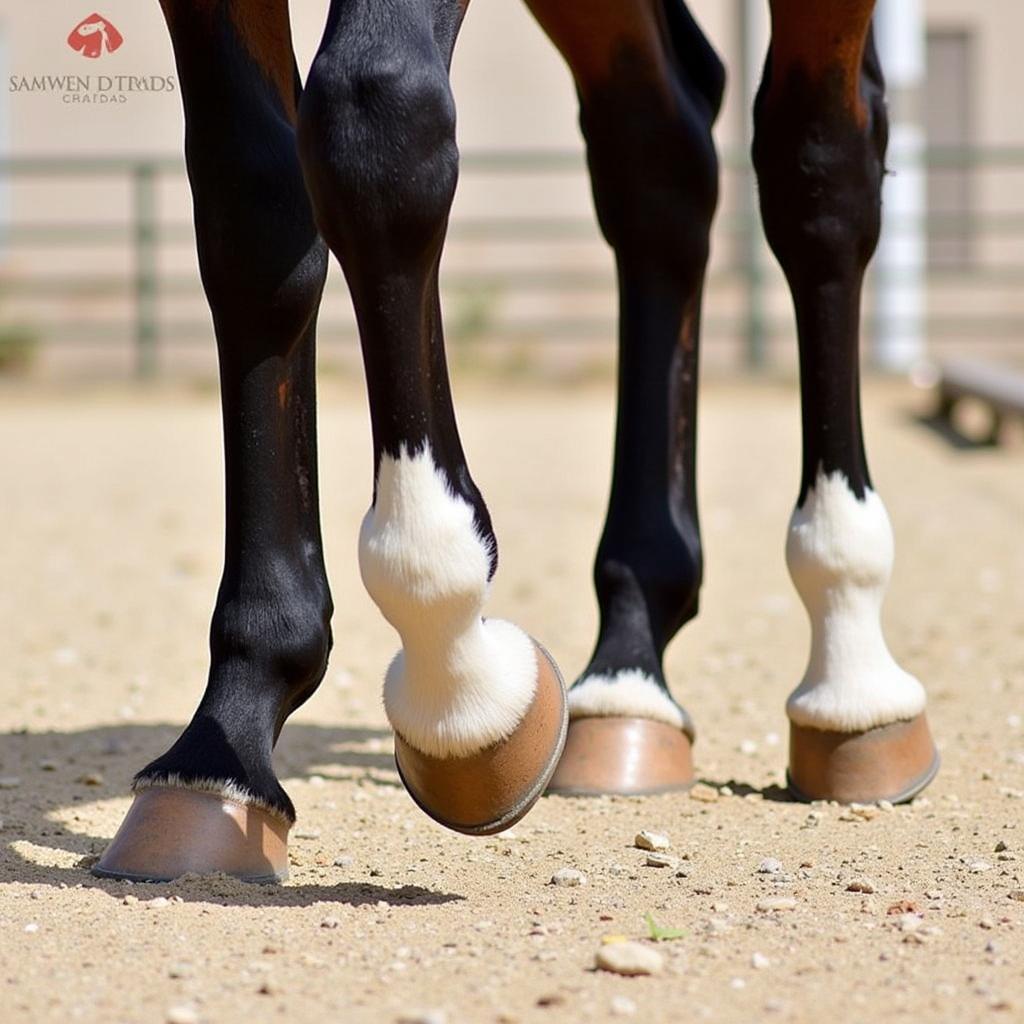The term “Bar Shoe Horse” refers to a horse wearing a bar shoe, a specialized horseshoe designed to provide extra support and protection to the hooves. Far from a one-size-fits-all solution, bar shoes serve specific therapeutic purposes and are prescribed by equine veterinarians or farriers to address a variety of hoof conditions. This article delves into the intricacies of bar shoes, exploring their applications, benefits, and potential drawbacks, enabling horse owners to make informed decisions regarding their horse’s hoof care.
What is a Bar Shoe for Horses?
A bar shoe differs from a traditional horseshoe by the presence of a solid metal bar connecting the two heels of the shoe. This bar distributes weight across the entire back of the hoof, limiting movement in the heel region. This specialized design makes them an invaluable tool for treating a wide range of hoof issues.
 Bar Shoe Anatomy
Bar Shoe Anatomy
Reasons for Using Bar Shoes for Horses
Veterinarians and farriers may recommend bar shoes for horses for various reasons, including:
Therapeutic Applications:
-
Heel Support and Pain Relief: Bar shoes provide crucial support to the heels, alleviating pain and promoting healing in horses suffering from conditions like navicular disease, laminitis, and certain tendon or ligament injuries. By limiting heel movement, the shoe minimizes strain on sensitive structures in these areas.
-
Hoof Crack Management: Quarter cracks, vertical fissures in the hoof wall, can benefit significantly from bar shoes. The added stability reduces movement within the hoof capsule, fostering a healthy environment for crack healing.
-
Tendon and Ligament Injuries: Injuries to tendons and ligaments in the lower leg often necessitate restricted movement to facilitate healing. Bar shoes effectively limit strain on these structures, allowing them to recover.
Preventative Measures:
-
Hoof Imbalance: Horses with conformation flaws or uneven hoof growth patterns can benefit from bar shoes to help maintain proper hoof balance and prevent further complications.
-
Performance Horse Support: Some performance horses, particularly those engaging in disciplines involving intense stress on the hooves, might wear bar shoes temporarily for added support and injury prevention.
 Horse Fitted with Bar Shoes
Horse Fitted with Bar Shoes
Types of Bar Shoes
Several types of bar shoes exist, each tailored to address specific hoof conditions:
-
Straight Bar Shoe: The most common type, featuring a straight bar across the heels.
-
Egg Bar Shoe: Shaped like an egg, this shoe extends further back, providing increased support to the frog and digital cushion.
-
Heart Bar Shoe: Similar to an egg bar but with a wider, heart-shaped section, offering maximum frog support.
 Different Bar Shoe Designs
Different Bar Shoe Designs
Potential Drawbacks of Bar Shoes
While beneficial in many cases, bar shoes do come with potential drawbacks:
-
Traction Concerns: The bar can reduce traction, especially on slick surfaces.
-
Snow and Debris Buildup: The bar can trap snow and debris, potentially leading to discomfort or even injury.
-
Increased Farrier Care: Bar shoes typically require more frequent resetting or adjustments by a farrier compared to regular horseshoes.
Choosing the Right Shoe: Consulting a Professional
Deciding whether a horse needs bar shoes rests solely on the expertise of a qualified equine veterinarian or farrier. They can assess the horse’s individual needs, considering factors such as:
-
Underlying Hoof Condition: The specific type and severity of the hoof problem play a pivotal role in shoe selection.
-
Conformation and Movement: The horse’s natural conformation, gait, and intended use factor into the decision.
-
Environment and Activity Level: The horse’s living environment and activity level can influence shoe choice and the frequency of farrier visits.
Frequently Asked Questions about Bar Shoes for Horses
1. How long can a horse wear bar shoes?
The duration a horse wears bar shoes depends on the underlying condition and the veterinarian or farrier’s recommendations. It can range from a few weeks to several months, or even become a long-term solution in some cases.
2. Can bar shoes be used on all horses?
Bar shoes are not suitable for every horse. They require careful assessment by a professional to determine their appropriateness for a particular horse and situation.
3. Are there alternatives to bar shoes?
Yes, alternatives exist, such as different shoeing techniques, corrective trimming, or therapeutic hoof boots, depending on the specific hoof issue.
4. Do bar shoes hurt horses?
When properly fitted and applied by a skilled professional, bar shoes should not cause pain. In fact, they often alleviate discomfort associated with various hoof conditions.
5. Can I ride my horse with bar shoes?
Riding a horse with bar shoes depends on the veterinarian’s or farrier’s advice and the reason for using them. Some horses can continue their regular work, while others might require restricted activity during treatment.
Need Expert Advice?
Do you have questions about bar shoes or other hoof care concerns for your horse? Contact Justus Horses USA today! Our team of experienced professionals is dedicated to providing personalized guidance and support for all your horse care needs.
Call us at: 0772127271
Email us at: [email protected]
Visit us at: QGM2+WX2, Vị Trung, Vị Thuỷ, Hậu Giang, Việt Nam
We offer 24/7 customer support to ensure your peace of mind. Explore our website for more informative articles about bar shoes for horses and other equine-related topics. You can also find resources about the exciting world of women horse and learn more about horse shoe nail care. We believe in empowering horse owners with knowledge and helping them provide the best care possible for their equine companions.